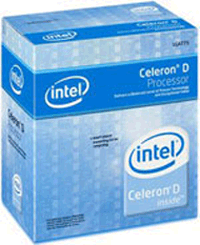Intel Celeron D 331

Availability: Phased Out
Comparison Chart:
| Intel® Celeron® D 347 Processor | Intel® Celeron® D 331 Processor | Intel® Celeron® Processor 440 | Intel® Celeron® Processor 430 | Intel® Celeron® Processor 420 | |
| Processor Number | 347 | 331 | 440 | 430 | 420 |
| Architecture | 65 nanometer | 90 nanometer | 65 nanometer | 65 nanometer | 65 nanometer |
| L2 Cache | 512 KB | 256 KB | 512 KB | 512 KB | 512 KB |
| L3 Cache | NA | NA | NA | NA | NA |
| Clock Speed | 3.06 GHz | 2.66 GHz | 2 GHz | 1.80 GHz | 1.60 GHz |
| Front Side Bus | 533 MHz | 533 MHz | 800 MHz | 800 MHz | 800 MHz |
| Package | FC-LGA | FC-LGA | FC-LGA | FC-LGA | FC-LGA |
| Slot/Socket Type | LGA775 | LGA775 | LGA775 | LGA775 | LGA775 |
| Min-Max Operating Voltage | 1.25V – 1.325V | 1.25-1.40v | NA | NA | NA |
| sSpec Number | SL9XU | SL7TV | SL9XL | SL9XN | SL9XP |
Glossary Definitions:
Architecture
The size and spacing of the processors's transistors (silicon etchings), which
partially determine the switching speed. The diameter of transistors is measured
in microns. One micron is one-millionth of a meter. The 90 nm (a nanometer is
one-billionth of a meter) process combines higher-performance, lower-power
transistors, strained silicon, high-speed copper interconnects and a new low-k
dielectric material. For more information see: http://www.intel.com/research/silicon/nanometer.htm
Clock Speed
The speed at which the processor executes instructions. Every processor contains
an internal clock that regulates the rate at which instructions are executed. It
is expressed in Megahertz (MHz), which is 1 million cycles per second or
Gigahertz (GHz), which is 1 billion cycles per second.
Front Side Bus
The speed of the bus that connects the processor to main memory (RAM). As
processors have become faster and faster, the system bus has become one of the
chief bottlenecks in modern PCs. Typical bus speeds are 400 MHz, 533 MHz, 667
MHz, and 800 MHz.
L2 Cache
The size of 2nd level cache. L2 Cache is ultra-fast memory that buffers
information being transferred between the processor and the slower RAM in an
attempt to speed these types of transfers.
L3 Cache
The size of 3rd level cache, typically larger than L2. L3 Cache is ultra-fast
memory that buffers information being transferred between the processor and the
slower RAM in an attempt to speed these types of transfers. Integrated Level 3
cache provides a faster path to large data sets stored in cache on the
processor. This results in reduced average memory latency and increased
throughput for larger High-end Desktop workloads
Min-Max Operating Voltage
A voltage range is often provided for processors to allow a single voltage
regulator module (VRM) on motherboards to work with all processor frequencies
supported by that motherboard. The voltage set by the VID pins (voltage ID) on
the processor is the maximum voltage allowed by the processor. The minimum
voltage fluctuates with the processor frequency allowing processors running at a
higher frequency to have a relaxed minimum voltage specification.
Package
The physical packaging or form factor (size, shape, number and layout of the
pins or contacts) in which the processor is manufactured. There are many
different package types for Intel® processors. See the Processor Package Type
Guide for photos and details.
Slot/Socket Type
A motherboard is designed for a certain range of processors. One of the
determining factors of processor compatibility is the slot or socket connector
soldered onto the board. 242-contact and 330-contact slot connectors were used
for a short time to allow for L2 cache to be packaged close to the processor
die. Processor manufacturing advancements now allow L2 cache to be manufactured
on the same die as the processor, requiring a smaller form-factor processor
packaging. PGA (pin grid array) sockets are more common, flexible, and compact,
but have many variations in the amount of pin connects and pin layouts.
sSpec Number
Also known as specification number. A five character string (SL36W, XL2XL, etc.)
that is printed on the processor, and used to identify the processor. By knowing
the processor's sSpec Number, you can find out the processor's core speed, cache
size and speed, core voltage, maximum operating temperature and so on.
